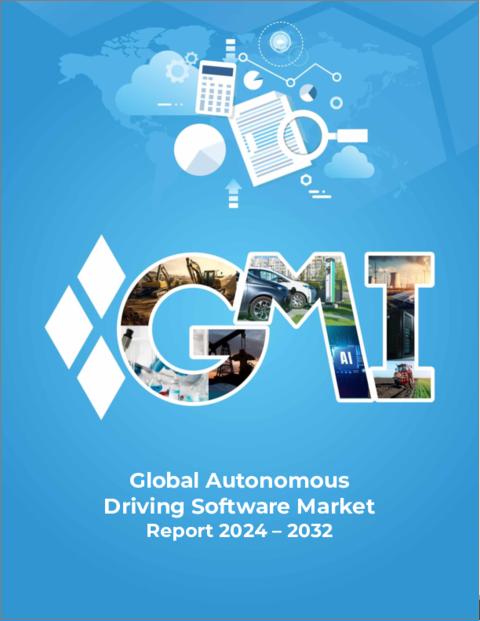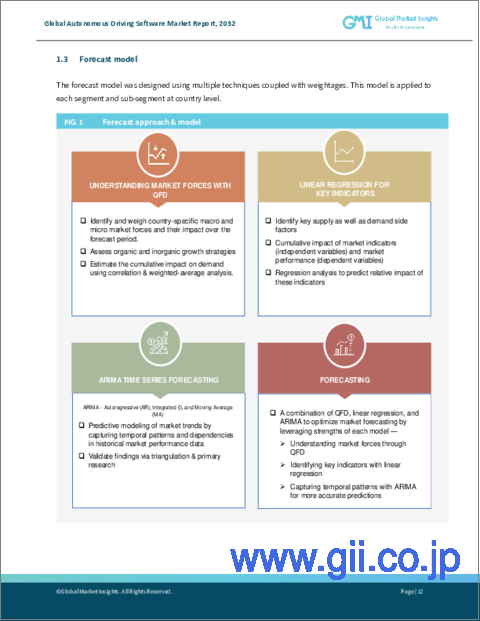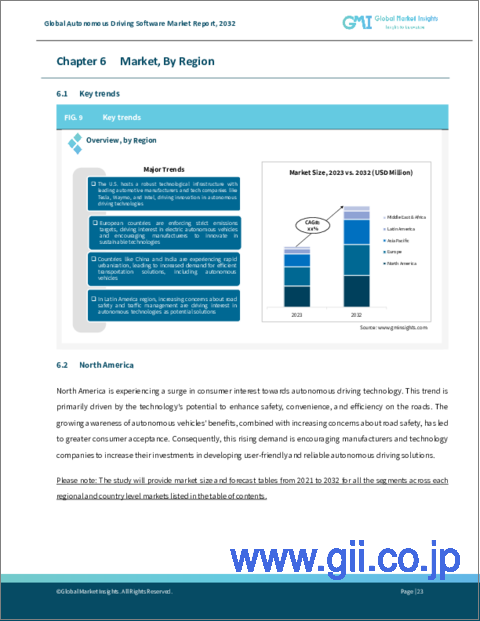|
|
市場調査レポート
商品コード
1620568
自律走行ソフトウェア市場の成長機会、成長促進要因、産業動向分析、2024~2032年予測Autonomous Driving Software Market Opportunity, Growth Drivers, Industry Trend Analysis, and Forecast 2024 to 2032 |
||||||
カスタマイズ可能
|
|||||||
| 自律走行ソフトウェア市場の成長機会、成長促進要因、産業動向分析、2024~2032年予測 |
|
出版日: 2024年10月23日
発行: Global Market Insights Inc.
ページ情報: 英文 180 Pages
納期: 2~3営業日
|
- 全表示
- 概要
- 目次
自律走行ソフトウェアの世界市場は、2023年に18億米ドルと評価され、2024~2032年にかけてCAGR13.4%で成長すると予測されています。
この急拡大は主に、自律走行技術に適した先進的デジタルインフラを提供する、電気自動車や環境に優しい自動車へのシフトが進んでいることが背景にあります。電気自動車(EV)は、自動運転機能に不可欠なセンサー、人工知能(AI)システム、通信技術を統合するための理想的なプラットフォームです。さらに、世界各国の政府は、補助金、税制優遇措置、排ガス規制を通じてEVの導入を支援しており、サステイナブル輸送を好む消費者の増加に伴い、自動車メーカーが電気自動車と自律走行車の両方を優先するよう促しています。政府の支援も自律走行ソフトウェア市場の成長を促す重要な要因です。
北米、欧州、アジアの各国は、助成金、補助金、技術革新を奨励し、輸送の安全性を向上させ、二酸化炭素排出量を削減するように設計された支援的な規制枠組みを通じて、自律走行車(AV)研究を支援しています。自律走行車のための指定検査区域やパイロットプログラムの確立は技術的進歩を加速させ、検査規制の緩和やメーカーに対する減税などのインセンティブは、自律走行ソフトウェア開発への投資をより多くの企業に促しています。これらの施策は、財政的・規制的課題を克服し、自律走行技術の幅広い展開を促進するために不可欠です。市場セグメンテーションを車種別に見ると、乗用車が支配的なセグメントであり、2023年の市場シェアの70%以上を占める。この優位性は、安全への懸念や規制要件に後押しされて、個人所有の自動車でADAS(先進運転支援システム)の需要が高まっていることによります。
アダプティブクルーズコントロール、レーンキーピングアシスタンス、自動緊急ブレーキなどの機能が標準化されつつあり、乗用車への自動運転ソフトウェアの統合を後押ししています。ライドヘイリングやシェアードモビリティ用途の可能性が、このセグメントにおける自律走行ソフトウェアの需要をさらに押し上げ、乗用車を主要成長セグメントとして位置付けています。推進力に関しては、電気自動車はその先進的電子システムにより自律走行技術との互換性が高いため、2023年にはEVセグメントが市場シェアの約62%を占めました。EVの運転効率とメンテナンスの必要性の低減は、特に物流やライドヘイリングのようなセグメントでの自律走行用途にとって魅力的な選択肢となっています。
| 市場範囲 | |
|---|---|
| 開始年 | 2023年 |
| 予測年 | 2024~2032年 |
| 開始金額 | 18億米ドル |
| 予測金額 | 55億米ドル |
| CAGR | 13.4% |
地域別では、北米が2023年に35%以上のシェアで市場をリードしており、米国は技術の進歩とAVテストに対する政府の支援を通じて急速な進歩を示しています。欧州も主要な貢献国であり、強力な研究開発投資と、持続可能性と輸送の安全性に焦点を当てた政府の好意的な施策に支えられています。
目次
第1章 調査手法と調査範囲
第2章 エグゼクティブサマリー
第3章 産業洞察
- エコシステム分析
- サプライヤーの状況
- ハードウェアメーカー
- ソフトウェア開発企業
- 地図作成会社
- データプロバイダー
- システムインテグレーター
- 利益率分析
- コスト内訳分析
- 使用事例
- 技術とイノベーションの展望
- 主要ニュースと取り組み
- 規制状況
- 影響要因
- 促進要因
- 自律走行車開発に対する政府の取り組みと資金の増加
- 都市化の進展と交通渋滞の増加
- 電気自動車や環境に優しい自動車へのシフト
- 人工知能(AI)、機械学習、センサー技術の技術的進歩
- 産業の潜在的リスク・課題
- 地域によって異なる規制
- 研究開発に必要な高い開発コスト
- 促進要因
- 成長可能性分析
- ポーター分析
- PESTEL分析
第4章 競合情勢
- イントロダクション
- 企業シェア分析
- 競合のポジショニングマトリックス
- 戦略展望マトリックス
第5章 市場推定・予測:自動化レベル別、2021~2032年
- 主要動向
- レベル1
- レベル2
- レベル3
- レベル4
- レベル5
第6章 市場推定・予測:車両別、2021~2032年
- 主要動向
- 乗用車
- 商用車
第7章 推進力別市場推定・予測:推進力別、2021~2032年
- 主要動向
- 内燃機関
- 電気自動車
第8章 市場推定・予測:ソフトウェア別、2021~2032年
- 主要動向
- パーセプション&プランニングソフトウェア
- ドライバーソフトウェア
- 内装センシングソフトウェア
- モニタリングモニタリングソフトウェア
第9章 市場推定・予測:地域別、2021~2032年
- 主要動向
- 北米
- 米国
- カナダ
- 欧州
- 英国
- ドイツ
- フランス
- スペイン
- イタリア
- ロシア
- 北欧
- アジア太平洋
- 中国
- インド
- 日本
- 韓国
- ニュージーランド
- 東南アジア
- ラテンアメリカ
- ブラジル
- メキシコ
- アルゼンチン
- 中東・アフリカ
- アラブ首長国連邦
- 南アフリカ
- サウジアラビア
第10章 企業プロファイル
- Aptiv
- Aurora Innovation
- Baidu
- BlackBerry
- Bosch
- Continental AG
- Cruise(GM)
- Hitachi Astemo
- Huawei
- Kodiak Robotics
- Magna International
- Mobileye
- NVIDIA Corporation
- Pony.ai
- Qualcomm
- Tesla
- Valeo
- Waymo(Alphabet)
- ZF Friedrichshafen AG
- Zoox(Amazon)
The Global Autonomous Driving Software Market, valued at USD 1.8 billion in 2023, is anticipated to grow at a compound annual growth rate (CAGR) of 13.4% from 2024 to 2032. This rapid expansion is primarily fueled by the increasing shift toward electric and eco-friendly vehicles, which offer advanced digital infrastructures well-suited for autonomous technologies. Electric vehicles (EVs) are ideal platforms for integrating sensors, artificial intelligence (AI) systems, and communication technologies essential for self-driving features. Additionally, governments worldwide support EV adoption through subsidies, tax incentives, and emissions regulations, which encourage automakers to prioritize both electric and autonomous vehicles, in line with the growing consumer preference for sustainable transportation. Government support is another critical factor driving the growth of the autonomous driving software market.
Countries across North America, Europe, and Asia back autonomous vehicle (AV) research through grants, subsidies, and supportive regulatory frameworks designed to encourage innovation, improve transportation safety, and reduce carbon emissions. Establishing designated testing zones and pilot programs for autonomous vehicles has accelerated technological advancements, while incentives like relaxed testing regulations and tax breaks for manufacturers are prompting more companies to invest in autonomous software development. These measures are vital for overcoming financial and regulatory challenges and facilitating the broader deployment of autonomous driving technologies. Market segmentation by vehicle type highlights passenger cars as a dominant segment, accounting for over 70% of the market share in 2023. This dominance is driven by the growing demand for advanced driver-assistance systems (ADAS) in personal vehicles, spurred by safety concerns and regulatory requirements.
Features such as adaptive cruise control, lane-keeping assistance, and automatic emergency braking are becoming standard, boosting the integration of autonomous software in passenger cars. The potential for ride-hailing and shared mobility applications further drives the demand for autonomous software within this segment, positioning passenger cars as a major growth area. In terms of propulsion, the EV segment held around 62% of the market share in 2023, as electric vehicles are more compatible with autonomous technology due to their advanced electronic systems. EVs' operational efficiency and reduced maintenance needs make them an attractive choice for autonomous applications, especially in sectors like logistics and ride-hailing.
| Market Scope | |
|---|---|
| Start Year | 2023 |
| Forecast Year | 2024-2032 |
| Start Value | $1.8 Billion |
| Forecast Value | $5.5 Billion |
| CAGR | 13.4% |
Regionally, North America led the market with over 35% share in 2023, with the U.S. showing rapid progress through technological advancements and government support for AV testing. Europe is also a major contributor, supported by strong R&D investments and favorable government policies focused on sustainability and safety in transportation.
Table of Contents
Chapter 1 Methodology & Scope
- 1.1 Research design
- 1.1.1 Research approach
- 1.1.2 Data collection methods
- 1.2 Base estimates and calculations
- 1.2.1 Base year calculation
- 1.2.2 Key trends for market estimates
- 1.3 Forecast model
- 1.4 Primary research & validation
- 1.4.1 Primary sources
- 1.4.2 Data mining sources
- 1.5 Market definitions
Chapter 2 Executive Summary
- 2.1 Industry 360° synopsis, 2021 - 2032
Chapter 3 Industry Insights
- 3.1 Industry ecosystem analysis
- 3.2 Supplier landscape
- 3.2.1 Hardware manufacturers
- 3.2.2 Software developers
- 3.2.3 Mapping companies
- 3.2.4 Data providers
- 3.2.5 Systems integrators
- 3.3 Profit margin analysis
- 3.4 Cost breakdown analysis
- 3.5 Use cases
- 3.6 Technology & innovation landscape
- 3.7 Key news & initiatives
- 3.8 Regulatory landscape
- 3.9 Impact forces
- 3.9.1 Growth drivers
- 3.9.1.1 Increasing government initiatives and funding for autonomous vehicle development
- 3.9.1.2 Rising urbanization and increasing traffic congestion
- 3.9.1.3 The shift towards electric and eco-friendly vehicles
- 3.9.1.4 Technological advancements in artificial intelligence (AI), machine learning, and sensor technologies
- 3.9.2 Industry pitfalls & challenges
- 3.9.2.1 Varying regulations across regions
- 3.9.2.2 High development costs required for research and development
- 3.9.1 Growth drivers
- 3.10 Growth potential analysis
- 3.11 Porter's analysis
- 3.12 PESTEL analysis
Chapter 4 Competitive Landscape, 2023
- 4.1 Introduction
- 4.2 Company market share analysis
- 4.3 Competitive positioning matrix
- 4.4 Strategic outlook matrix
Chapter 5 Market Estimates & Forecast, By Level of Automation, 2021 - 2032 ($Bn)
- 5.1 Key trends
- 5.2 Level 1
- 5.3 Level 2
- 5.4 Level 3
- 5.5 Level 4
- 5.6 Level 5
Chapter 6 Market Estimates & Forecast, By Vehicle, 2021 - 2032 ($Bn)
- 6.1 Key trends
- 6.2 Passenger car
- 6.3 Commercial vehicle
Chapter 7 Market Estimates & Forecast, By Propulsion, 2021 - 2032 ($Bn)
- 7.1 Key trends
- 7.2 ICE
- 7.3 Electric vehicles
Chapter 8 Market Estimates & Forecast, By Software, 2021 - 2032 ($Bn)
- 8.1 Key trends
- 8.2 Perception & planning software
- 8.3 Chauffeur software
- 8.4 Interior sensing software
- 8.5 Supervision/monitoring software
Chapter 9 Market Estimates & Forecast, By Region, 2021 - 2032 ($Bn)
- 9.1 Key trends
- 9.2 North America
- 9.2.1 U.S.
- 9.2.2 Canada
- 9.3 Europe
- 9.3.1 UK
- 9.3.2 Germany
- 9.3.3 France
- 9.3.4 Spain
- 9.3.5 Italy
- 9.3.6 Russia
- 9.3.7 Nordics
- 9.4 Asia Pacific
- 9.4.1 China
- 9.4.2 India
- 9.4.3 Japan
- 9.4.4 South Korea
- 9.4.5 ANZ
- 9.4.6 Southeast Asia
- 9.5 Latin America
- 9.5.1 Brazil
- 9.5.2 Mexico
- 9.5.3 Argentina
- 9.6 MEA
- 9.6.1 UAE
- 9.6.2 South Africa
- 9.6.3 Saudi Arabia
Chapter 10 Company Profiles
- 10.1 Aptiv
- 10.2 Aurora Innovation
- 10.3 Baidu
- 10.4 BlackBerry
- 10.5 Bosch
- 10.6 Continental AG
- 10.7 Cruise (GM)
- 10.8 Hitachi Astemo
- 10.9 Huawei
- 10.10 Kodiak Robotics
- 10.11 Magna International
- 10.12 Mobileye
- 10.13 NVIDIA Corporation
- 10.14 Pony.ai
- 10.15 Qualcomm
- 10.16 Tesla
- 10.17 Valeo
- 10.18 Waymo (Alphabet)
- 10.19 ZF Friedrichshafen AG
- 10.20 Zoox (Amazon)






